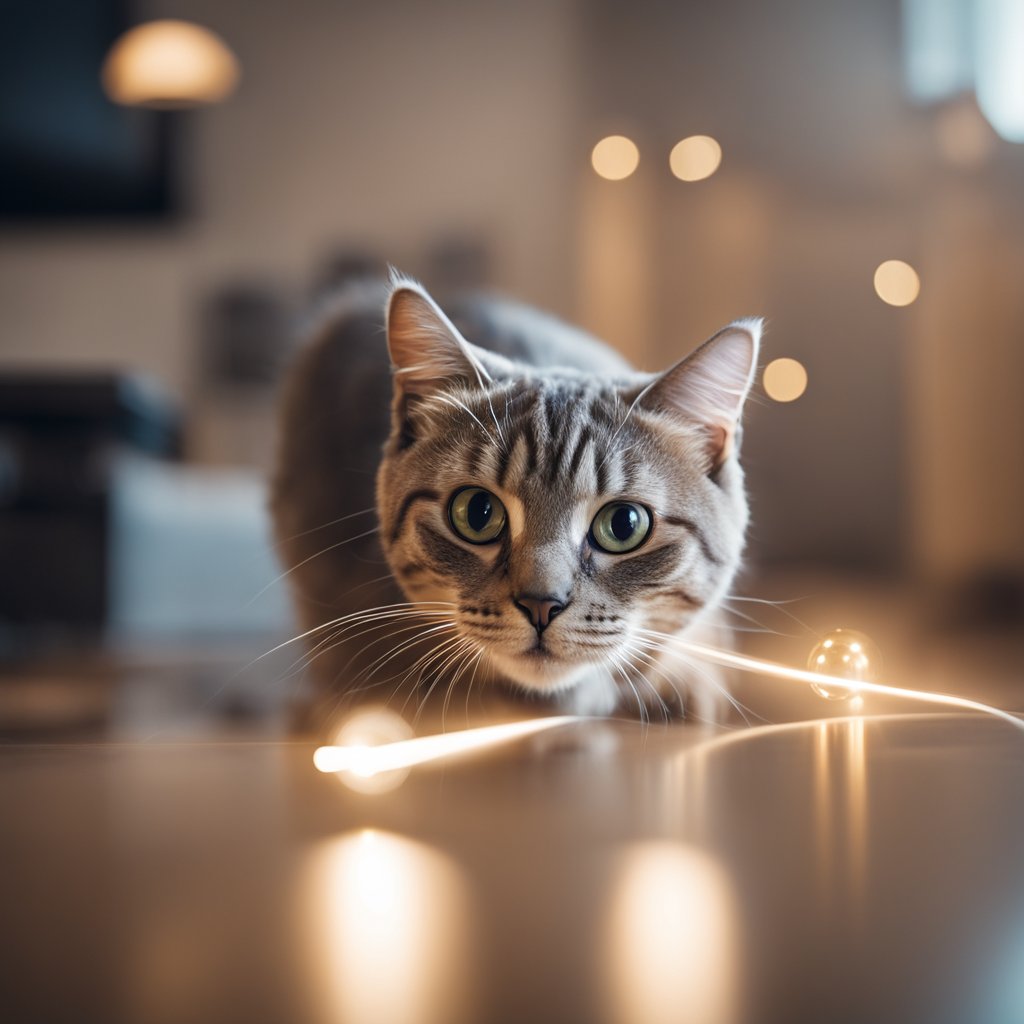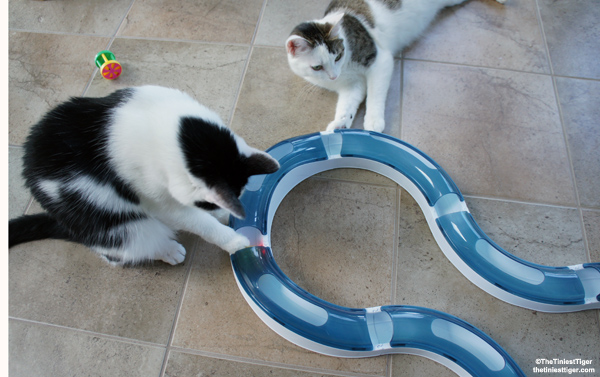
Cats and Laser Toys: Safety Tips and Warning
Laser toys for cats have become a popular choice for cat owners seeking to provide their cat companions with stimulating play that encourages natural hunting behaviors. These toys produce a moving laser dot that entices cats to chase and pounce, offering both mental and physical exercise. The seemingly erratic movements of the laser dot mimic the erratic flight or scurry of prey, triggering a cat’s predatory instincts.
Laser Toy Warning
However, recent studies suggest that while engaging, there may be implications for a cat’s well-being when these toys are used exclusively or improperly. Some cats exhibit a form of frustration or stress when they can’t physically catch or touch the elusive light spot, which may lead to abnormal repetitive behaviors (ARBs). Understanding the balance between entertainment and potential distress is crucial when incorporating laser toys into a cat’s routine. Cat parents must observe their cat’s reaction to the laser toy and complement their playtime with toys that can be caught and touched, allowing for a complete and satisfying play experience.
Key Takeaways
- Laser toys can stimulate a cat’s natural hunting instincts through play.
- Inappropriate or exclusive use of laser toys may lead to frustration in cats.
- Observing cat behavior and diversifying play with various interactive toys are essential for wellbeing.
Types of Laser Toys for Cats
Laser toys for cats come in varied designs, offering different modes of play to cater to a feline’s natural hunting instincts. These toys typically fall into categories such as handheld laser pointers, automatic laser toys, and those with interactive features.
Handheld Laser Pointers
Handheld laser pointers are the simplest form of laser cat toys. They allow an owner to control the laser manually, providing personalized interaction with their cat. These pointers are usually battery-operated and compact, making them portable and easy to use.
- Pros:
- Direct control over the play session.
- Builds a bond between the cat and the owner.
- Cons:
- Requires constant human involvement.
- Risks of the laser being pointed directly at the cat’s eyes.
Automatic Laser Toys
Automatic laser toys are designed to operate without the need for human assistance, offering various settings to keep a cat entertained. They can be set to project the laser in random patterns and can shut off after a set amount of time to prevent overstimulation.
- Operation Modes:
- Manual Mode: Allows the owner to create a unique play experience.
- Automatic Mode: Randomly generates laser movements.
- Key Features:
- Timers for controlled play sessions.
- Adjustable laser speeds and patterns.
Interactive Laser Toy Features
Interactive laser toys combine the best of both handheld and automatic toys, often featuring manual and automatic modes. They may include motion sensors to react to a cat’s movement or additional features like sound effects to further engage a cat’s hunting behavior.
- Notable Attributes:
- Customizable settings for tailored play.
- Sensors that respond to a cat’s actions for a dynamic experience.
By incorporating these elements, interactive laser toys aim to provide a stimulating and enriching environment for indoor cats, reducing the chances of boredom or development of abnormal repetitive behaviors.

Understanding Cat Behavior and Play
Play is an essential component of a cat’s daily routine, providing both mental stimulation and physical exercise. It is a manifestation of their instinctual behaviors and contributes to their overall well-being.
The Role of Play in Feline Well-Being
Play is vital for a cat’s well-being, serving not only as a means for physical workout but also as necessary mental engagement. Through play, cats engage in activities that simulate hunting and predatory behaviors, which are part of their natural instincts. This prey drive is essential for their development and sustenance of their instinctual skills.
- Mental Stimulation: Play keeps cats mentally alert and engaged, preventing boredom and potential behavioral issues.
- Exercise: Regular play ensures that cats maintain a healthy weight and muscle tone, contributing to overall physical health.
Instinctual Behaviors in Cats
Cats exhibit a range of behaviors during play that reflect their hunting instincts. These behaviors include stalking, pouncing, and chasing, all of which are crucial for a cat’s survival in the wild. In a domestic setting, such behaviors are expressed through play as it satisfies their inherent predatory instincts without the need to hunt live prey.
- Stalking and Pouncing: Cats often exhibit these behaviors when interacting with toys that move erratically, mimicking the movements of prey.
- Chasing: Toys that move quickly, such as laser pointers, can trigger a cat’s prey drive, prompting them to chase and “capture” the moving target.
Engaging in these instinctual activities through play provides cats with the necessary exercise and mental stimulation which is integral to their health and happiness. It is important for cat owners to facilitate this essential aspect of feline behavior with appropriate toys and interaction.
Responsible Toy Usage
Selecting appropriate toys for cats, including laser toys, requires understanding the balance between stimulation and safety. Responsible usage ensures a positive experience for the cat without any adverse effects.
Limiting Play Time
Laser toys, whether automatic or manual, should be used in moderation to prevent overstimulation in cats. Cats may become frustrated if they cannot catch the ever-elusive laser dot. It’s recommended to limit laser play sessions to a few minutes per day, ensuring the cat also engages in interactive play with tangible objects it can catch.
- Frequency: Engage cats in laser play no more than twice a day.
- Duration: Keep each session under 15 minutes to prevent exhaustion and frustration.
Monitor the cat’s behavior during play, and if signs of stress or obsessive behavior surface, it’s time to switch to physical toys. Interactive toys that mimic prey movements can provide a satisfying end to play by allowing the cat to ‘catch’ something, which the laser dot does not offer.
Using automated laser toys requires supervision to ensure that the laser does not shine directly into the cat’s eyes, preserving its vision and well-being. Adjust automated toys to vary the speed and path of the laser to keep play intriguing and unpredictable for the cat.

Safety and Health Considerations
When introducing laser toys as a form of entertainment for cats, it is crucial to prioritize their safety and well-being. The following subsections delve into two significant aspects: protecting the cat’s eyes from potential harm and the necessity of monitoring play sessions.
Eye Safety with Laser Toys
Direct exposure to laser light can cause eye damage in cats, just as it can in humans. Therefore, it is essential that laser toys are used responsibly to avoid shining the beam directly into a cat’s eyes.
- Precautions to Take:
- Use low-intensity laser toys designed specifically for pets.
- Keep the laser beam moving and avoid pointing it at a cat’s face.
Importance of Supervised Play
Supervision during play ensures that interactions with laser toys remain safe and positive. Adults, rather than children, should oversee playtime to ensure lasers are used appropriately.
- Key Supervision Tips:
- Monitor the cat’s reactions to prevent overstimulation.
- Supervise children at all times to prevent accidental eye exposure.

Additional Interactive Cat Toy Options
Cats benefit from a variety of interactive toys that go beyond laser pointers. These options can cater to different play styles and offer enrichment for various feline personalities.
Incorporating Various Toy Types

The best cat toys are those that engage a cat’s natural instincts. Toy types to consider include:
- Wand Toys: These mimic prey movements and provoke pouncing.
- Ball Tracks: Balls set in tracks can provide hours of batting fun.
- Interactive Feeders: These toys stimulate the mind by making cats work for treats.
A comprehensive toy collection should feature a mix of sensory stimuli such as textures, sounds, and movements, keeping a cat’s interest peaked and decreasing the likelihood of boredom.
Motion-activated toys serve as excellent stimuli for play and exercise. These products can detect a cat’s movement and respond accordingly, often with unpredictable patterns that mimic live prey.
- Motion Sensor Toys: They activate when a cat is near, encouraging stalking and hunting behavior.
When selecting toys with multiple modes, cat parent should consider safety features like automatic shut-off to prevent overstimulation.
Ensuring Long-Term Engagement
To maintain an indoor cat’s interest in their toys, it’s critical to use a strategic approach that encourages consistent interaction and prevents boredom.
Variety and Rotation of Toys
For indoor cats, short sessions with these toys are preferable. Brief and frequent play periods prevent overstimulation and mimic the natural hunting behaviors of felines, promoting short but intense bursts of activity. A structured routine that alternates between the different toy options can keep a cat invested in the game, providing both physical exercise and mental stimulation.
The process of rotating toys not only helps to keep a cat’s environment novel and intriguing but also prolongs the lifespan of the toys themselves, ensuring long-term engagement and interest.

Frequently Asked Questions
In this section, pet owners can find concise, expert insights into commonly asked questions about the interaction between cats and laser pointer toys.
What are the benefits of playing with laser pointers for cats?
Laser pointers can encourage physical activity and provide mental stimulation for cats by appealing to their natural hunting instincts.
Can laser pointer play cause anxiety or stress in cats?
Excessive or improper use of laser pointers may lead to frustration, as the lack of a tangible reward might cause stress or anxiety for some cats.
Is it safe to use a laser pointer as a toy with my cat?
Laser pointers are generally safe when used responsibly, but it is crucial to avoid shining the light directly into a cat’s eyes to prevent potential harm.
How can automatic laser pointers be used to entertain cats?
Automatic laser pointers can engage cats in play by moving randomly across surfaces, thus stimulating their predatory behaviors without the need for constant human interaction.
Why are cats so fascinated by laser pointer lights?
Cats are attracted to the rapid, unpredictable movements of laser lights, which mimic the motions of prey, thus triggering their predatory instincts.
What precautions should be taken when using laser pointers with cats?
Guardians should supervise play to ensure safety, provide alternative toys for tactile feedback, and conclude laser sessions with a tangible reward to prevent behavioral issues.